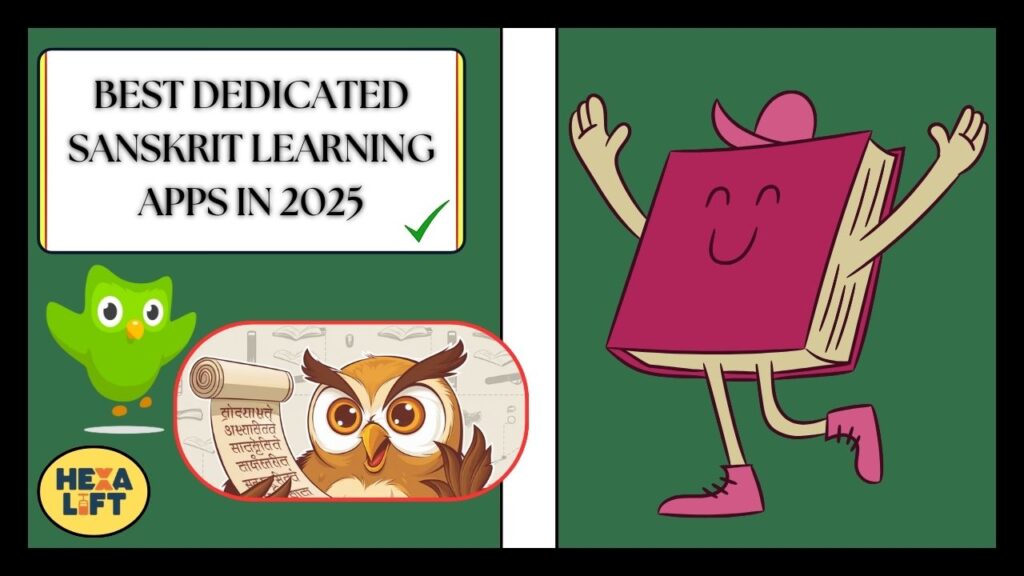Does Duolingo Have Sanskrit?: In the ever-expanding universe of language learning apps, Duolingo stands tall as one of the most recognized platforms with its friendly green owl mascot and gamified approach.
For those interested in ancient languages with profound cultural significance, Sanskrit often tops the list of desired learning options.
If you’ve been wondering whether you can learn this classical language through the popular platform, you’ve come to the right place.
Sanskrit’s Rich Heritage and Modern Significance
Sanskrit isn’t just another language it’s a living connection to an ancient world. Dating back to 1500-500 BCE, this sophisticated language has earned the title of “the language of the gods” in Indian culture.
Its meticulous grammar system and vast vocabulary have fascinated linguists and polyglots throughout history.
The language holds immense significance beyond its historical value. As the liturgical language of Hinduism, Buddhism, and Jainism, Sanskrit remains central to religious ceremonies and philosophical texts.
The ancient Indus Valley Civilization gave birth to this language, which continues to influence modern South Asian languages like Hindi, Bengali, and Nepali.
In contemporary times, Sanskrit has found renewed interest for several compelling reasons:
- UNESCO recognized Sanskrit as an important part of humanity’s intangible cultural heritage
- The language’s logical structure has attracted attention for potential applications in programming and artificial intelligence
- Yoga practitioners worldwide encounter Sanskrit terms in their practice
- Academic institutions continue to study Sanskrit for its literary and philosophical treasures
“Sanskrit is not just a language; it’s the cultural DNA of India’s rich cultural heritage.” – Dr. Kapil Kapoor, Sanskrit scholar
Despite modernization, Sanskrit remains a cornerstone of traditional knowledge systems.
Its precise nature and mathematical structure make it uniquely valuable for logical analysis and philosophical exploration.
Duolingo’s Current Sanskrit Status in 2025
If you’ve been searching for Sanskrit on Duolingo, I’ll cut to the chase: As of March 2025, Duolingo does not offer a Sanskrit course.
Despite the language’s historical importance and growing interest, it hasn’t yet made its way onto the platform’s roster.
Duolingo’s approach to adding new languages involves several considerations:
| Factor | How it Affects Sanskrit Addition |
|---|---|
| Global Demand | Sanskrit has dedicated enthusiasts but smaller numbers compared to modern languages |
| Technical Complexity | Sanskrit’s case system and complex script present unique challenges |
| Resource Allocation | Duolingo prioritizes languages with higher user demand |
| Volunteer Availability | The Incubator program requires dedicated contributors |
The platform has gradually expanded its offerings to include some ancient languages like Latin, but Sanskrit presents distinctive challenges.
The Devanagari script, complex grammar rules, and specialized teaching requirements make it a significant undertaking for Duolingo’s development model.
When comparing with other classical languages on Duolingo:
- Latin has been available since 2019
- Ancient Greek was introduced in specific course formats
- Biblical Hebrew has a dedicated course
While Sanskrit enthusiasts have created community petitions and requests through Duolingo’s language suggestion channels, the company hasn’t announced any immediate plans to add Sanskrit to their lineup.
Also Read: Where Is The Duolingo Shop? Ultimate Guide For 2025
Why Sanskrit Isn’t on Duolingo Yet
Several factors contribute to Sanskrit’s absence from Duolingo’s language roster:
Limited Global Demand vs. Development Resources
Duolingo operates as a business, and language learning apps must prioritize development resources based on potential user numbers.
While Sanskrit has passionate advocates, the global demand pales in comparison to languages like Spanish, French, or Japanese.
The company tends to prioritize languages with:
- Larger potential user bases
- Commercial applications
- Educational system requirements
Sanskrit, despite its cultural importance, represents a niche market compared to widely spoken modern languages.
Technical Teaching Challenges in Sanskrit
Sanskrit presents unique technical challenges that make it particularly difficult to implement in Duolingo’s standardized format:
- The Devanagari script requires specialized keyboard implementation
- Sanskrit’s complex Sanskrit grammar includes:
- Eight cases
- Three numbers (singular, dual, plural)
- Three genders
- Elaborate verb conjugation systems
- Proper pronunciation requires precise attention to sounds not found in English
These complexities make creating effective, bite-sized lessons Duolingo’s specialty particularly challenging.
The platform’s strength lies in teaching vocabulary and basic grammar through repetition, which doesn’t align perfectly with Sanskrit’s intricate structure.
Platform Development Priorities
Duolingo’s business model focuses on:
- Languages with broad appeal
- Languages requested by educational systems
- Languages with commercial applications
The company must balance user requests with business considerations. While Sanskrit has significant cultural significance, its immediate practical applications for most learners are more limited than modern languages used in business, travel, or everyday communication.

Best Dedicated Sanskrit Learning Apps in 2025
While Duolingo doesn’t currently offer Sanskrit, several specialized applications have stepped in to fill this gap with impressive results:
Little Sanskrit: Beginner-Friendly Approach
Little Sanskrit offers a gentle introduction to this ancient language with:
- Progressive learning from basic alphabet to simple sentences
- Audio pronunciations by native Sanskrit scholars
- Visual associations for easier memorization
- Daily practice sessions of 10-15 minutes
The app’s strength lies in its accessibility for complete beginners, making the intimidating aspects of Sanskrit more approachable.
Sanskrit Language Tools: Comprehensive Reference
This powerful app serves as both learning platform and reference tool with:
- Comprehensive Sanskrit vocabulary dictionary with over 120,000 entries
- Detailed explanations of Sanskrit grammar rules
- Text analysis tools for breaking down complex sentences
- Pronunciation guides with audio examples
For serious students, this app provides depth beyond simple phrase learning, making it valuable throughout your Sanskrit journey.
Ashtadhyayi Academy: Advanced Sanskrit Studies
Named after Panini’s famous grammar treatise, this app caters to advanced learners:
- In-depth analysis of Sanskrit’s grammatical system
- Original text studies with commentary
- Vedic Sanskrit variations and historical development
- Community discussions with Sanskrit scholars
This app isn’t for casual learners but provides extraordinary depth for those committed to mastering the language.
Also Read: Duolingo Max Price: The Comprehensive Guide For 2025
Comprehensive Sanskrit Courses on Major Platforms
Several established language platforms offer structured Sanskrit learning experiences:
Memrise: Community-Created Sanskrit Resources
Memrise utilizes its spaced repetition system along with user-generated content to teach Sanskrit:
- Multiple Sanskrit courses created by community members
- Vocabulary-focused approach with mnemonic techniques
- Audio pronunciations and visual associations
- Progressive difficulty levels from beginner to advanced
Memrise’s strength is its flashcards and memory techniques, which work especially well for building vocabulary.
The platform offers both free and premium options, with the free version providing access to most Sanskrit content.
Liberation Philology Sanskrit: Grammar-Focused Learning
Liberation Philology Sanskrit takes a more traditional approach to language learning:
- Structured grammar lessons following classical teaching methods
- Comprehensive noun and verb tables
- Translation exercises in both directions
- Quizzes and progress tracking
This platform excels for analytical learners who appreciate understanding the underlying structure of language.
Its systematic approach mirrors traditional Sanskrit teaching methods.
Udemy & Coursera: Academic Sanskrit Courses
Major online learning platforms offer instructor-led Sanskrit courses:
- Complete beginner to intermediate curriculums
- Video lectures with professional instructors
- Downloadable practice materials
- Certificate options upon completion
These platforms provide a classroom-like experience with the flexibility of online learning. Prices typically range from $12-$99 depending on the course depth and instructor credentials.
Professional Sanskrit Tutoring Services
For personalized learning experiences, several tutoring platforms connect students with Sanskrit experts:
iTalki & Preply: One-on-One Sanskrit Instruction
These global tutoring marketplaces feature:
- Verified iTalki tutors specializing in Sanskrit
- Customizable lesson schedules and formats
- Options from conversational practice to academic rigor
- Pricing ranging from $10-$40 per hour based on tutor experience
The main advantage of platforms like Preply is personalization your tutor can adapt to your learning style, focus on your specific interests, and provide immediate feedback on pronunciation.
Vedic Gurukul Online: Traditional Teaching Methods
This specialized platform maintains traditional teaching approaches in a digital format:
- Sanskrit taught following ancient gurukul methods
- Emphasis on proper pronunciation and recitation
- Cultural and philosophical context alongside language
- Group and individual instruction options
For those interested in Sanskrit’s religious and cultural applications, this traditional approach provides authentic learning experiences.
University-Affiliated Sanskrit Programs
Several universities offer remote Sanskrit courses for academic credit:
- Structured curriculum following academic standards
- Access to library resources and research materials
- Possible credit transfer to degree programs
- Expert faculty with research backgrounds
While typically more expensive than app-based learning, these programs offer academic credibility and comprehensive instruction.
Many universities now offer non-degree options for language learners.

Innovative Interactive Sanskrit Apps
Modern technology has enabled creative approaches to teaching this ancient language:
Drops & Ling: Visual Learning for Sanskrit
These visually-oriented apps employ gamification techniques:
- Image associations for vocabulary retention
- Five-minute daily learning sessions
- Game-like challenges and achievements
- Focus on practical vocabulary acquisition
Both apps excel at making vocabulary learning engaging through vibrant visuals and quick sessions.
Their approach works particularly well for visual learners who benefit from image associations.
AI-Powered Sanskrit Learning Tools (2025)
Recent developments in AI have produced innovative tools:
- Adaptive learning algorithms that adjust to your progress
- Speech recognition for pronunciation feedback
- Personalized study plans based on performance
- Interactive chatbots for basic Sanskrit conversation practice
These cutting-edge tools represent the future of Sanskrit learning, combining ancient knowledge with modern technology for more effective learning outcomes.
Also Read: Where Is The Practice Button On Duolingo? Complete Guide (2025)
Language Exchange Communities for Sanskrit Practice
Practice makes perfect, and these communities offer opportunities to use Sanskrit with others:
HelloTalk & Tandem: Finding Sanskrit Conversation Partners
These language exchange apps connect learners worldwide:
- Find native or advanced Sanskrit speakers
- Exchange voice messages for pronunciation practice
- Create group discussions on Sanskrit topics
- Share written practice with correction feedback
While Sanskrit speakers are less numerous than those of modern languages, these platforms still host dedicated communities passionate about Sanskrit exchange.
Reddit’s r/Sanskrit: Community Support and Resources
This active subreddit serves as both learning resource and community:
- Regular threads for translation requests
- Shared learning materials and resources
- Question and answer forums for grammar clarification
- Discussion of Sanskrit texts and literature
The community’s collaborative nature makes it an excellent supplement to more structured learning approaches.
Discord Sanskrit Channels: Real-Time Conversation
Several Discord servers dedicated to Sanskrit provide:
- Voice channels for pronunciation practice
- Text channels for writing practice
- Regular study groups and challenges
- Shared resource libraries and learning tools
These communities offer the social dimension often missing from solo app learning, creating accountability and motivation through group participation.
Sanskrit Learning Resources Beyond Apps
Digital tools represent just one aspect of effective Sanskrit learning:
Digital Libraries: Original Sanskrit Texts
Several online repositories provide access to Sanskrit literature:
- The Digital Library of India
- GRETIL (Göttingen Register of Electronic Texts in Indian Languages)
- Sanskrit Documents Organization
- Internet Archive’s Sanskrit collections
These resources allow learners to experience authentic texts with translations and commentaries, providing cultural context alongside language practice.
YouTube Channels: Video Lessons and Pronunciation
Visual and audio learners benefit from channels like:
- Sanskrit Channel by Rashtriya Sanskrit Sansthan
- Sanskrit from Home
- Learn Sanskrit with Ashish
- Samskrita Bharati Official
These channels offer everything from basic alphabet lessons to advanced grammar explanations, often with high-quality visuals and native speaker pronunciation.
Podcasts: Audio Immersion for Sanskrit
Several podcasts provide listening practice:
- The Sanskrit Podcast
- Sanskrit with Sanat
- Samskrita Bharati Podcasts
- Vedic Chanting and Sanskrit Learning
These audio resources are particularly valuable for developing listening skills and proper pronunciation, offering convenient learning during commutes or exercise.
Future Prospects for Sanskrit on Duolingo
What does the future hold for Sanskrit on this popular platform?
Current Indicators of Potential Addition
Several factors suggest Sanskrit might eventually join Duolingo’s language roster:
- Increased community requests and petitions
- Duolingo’s gradual expansion into ancient languages
- Growing interest in Sanskrit for yoga and mindfulness practices
- The platform’s mission to “make education free and accessible to all”
However, no official announcements have been made regarding Sanskrit’s addition.
Community Petition Status
Multiple community petitions have gathered signatures requesting Sanskrit addition:
- Change.org petitions have accumulated thousands of signatures
- Regular requests appear in Duolingo’s official forums
- Social media campaigns occasionally trend among Sanskrit enthusiasts
While Duolingo monitors such requests, they haven’t publicly responded with specific plans for Sanskrit.
Alternative Paths Duolingo Might Take
Rather than a full course, Duolingo might consider:
- A basic Sanskrit introduction module
- A specialized course focusing on Sanskrit for yoga practitioners
- A limited course teaching the alphabet and basic vocabulary
- Partnerships with existing Sanskrit learning platforms
These approaches would require fewer resources while still addressing community interest.
Also Read: Why Did Duolingo Icon Change: A New Look And Purpose
Conclusion: Best Path to Sanskrit Fluency in 2025
While Duolingo doesn’t currently offer Sanskrit, the good news is that numerous alternatives exist many with approaches better suited to Sanskrit’s unique characteristics than Duolingo’s format would be.
For beginners, I recommend this learning pathway:
- Start with a specialized app like Little Sanskrit to learn the basics
- Supplement with Memrise for vocabulary building
- Join r/Sanskrit and Discord communities for motivation and questions
- Consider professional tutoring through iTalki once you’ve established basics
- Explore original texts through digital libraries as your skills advance
The most effective approach combines multiple resources rather than relying on a single app. Sanskrit, with its rich complexity and cultural depth, rewards a multifaceted learning strategy.
“The beauty of Sanskrit lies not just in mastering its forms, but in understanding the profound ideas it expresses with unmatched precision.” – Dr. Sheldon Pollock, Sanskrit scholar
Whether Duolingo eventually adds Sanskrit or not, the growing ecosystem of specialized learning tools ensures that this ancient language remains accessible to modern learners who appreciate its unparalleled precision and cultural significance.
FAQs About Learning Sanskrit in 2025
Will Duolingo add Sanskrit in the near future?
Duolingo hasn’t announced plans to add Sanskrit, though community interest continues to grow. The technical challenges and niche market position make it unlikely to be a top priority, but the platform’s expansion into ancient languages like Latin suggests it’s not impossible.
What’s the easiest way to start learning Sanskrit in 2025?
The most approachable entry point is specialized beginner apps like Little Sanskrit or the introductory courses on Memrise. These provide gentle introductions to the alphabet, basic vocabulary, and simple sentence structures without overwhelming new learners.
How long does it take to learn basic Sanskrit?
With consistent daily practice of 15-30 minutes, most learners can grasp basic reading, simple conversations, and essential grammar within 6-12 months. Reaching intermediate proficiency typically requires 2-3 years of regular study.
Can I learn Sanskrit without learning Devanagari script?
While romanized Sanskrit (transliteration) can help beginners, learning the Devanagari script is essential for serious study. Most quality resources teach both simultaneously, as the script captures pronunciation nuances that Roman letters cannot adequately represent.
Which Sanskrit app offers the best value for serious learners?
For committed learners, the combination of Sanskrit Language Tools and iTalki tutoring provides the most comprehensive approach. The former offers deep reference materials while the latter provides personalized guidance and conversation practice.
Are there free options for learning Sanskrit online?
Numerous free resources exist, including the basic versions of Memrise, community resources on r/Sanskrit, YouTube channels like Sanskrit from Home, and open-access digital libraries containing classical texts with translations.
How different is Sanskrit from modern Indian languages?
Sanskrit is to modern Indian languages what Latin is to Romance languages a sophisticated ancestor with more complex grammar. While languages like Hindi share vocabulary with Sanskrit, the grammar has simplified considerably in modern tongues. Knowledge of Sanskrit makes learning modern Indian languages easier, but they remain distinct languages.
Is Sanskrit harder to learn than other ancient languages?
Sanskrit presents unique challenges due to its complex grammar and non-Latin script, but its highly systematic nature makes it more logical than many ancient languages. Compared to Classical Chinese or Ancient Greek, Sanskrit has more consistent rules but a steeper initial learning curve due to its script and sound system.
Read more knowledgeable blogs on Hexa Lift

Holly Wallace is a Duolingo expert, providing insightful reviews, pricing details, and FAQs. She helps language learners navigate Duolingo effectively, making language learning accessible, engaging, and efficient for users of all levels.








